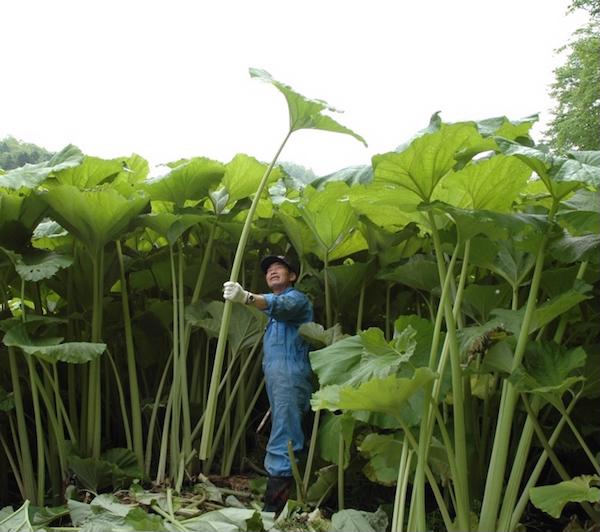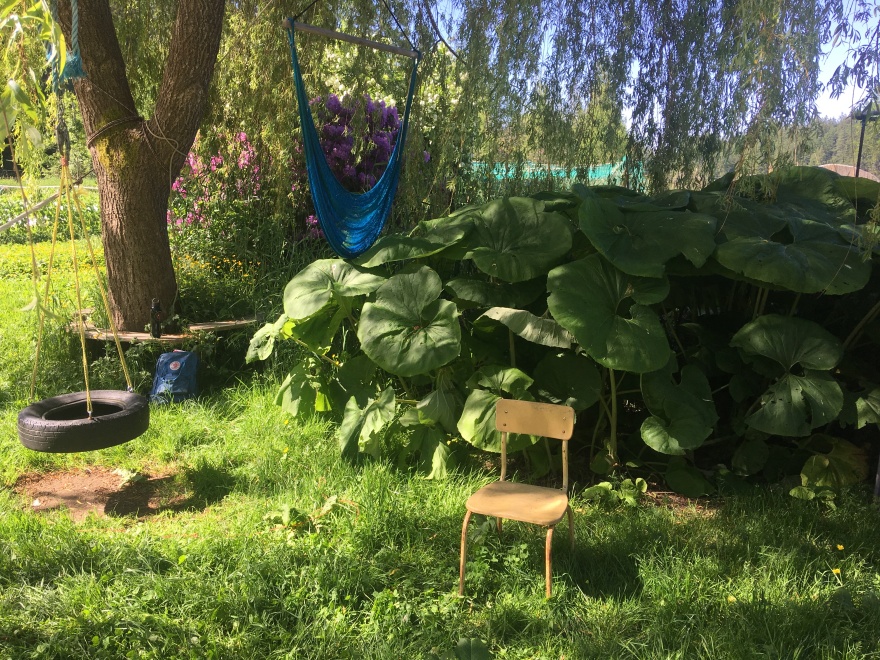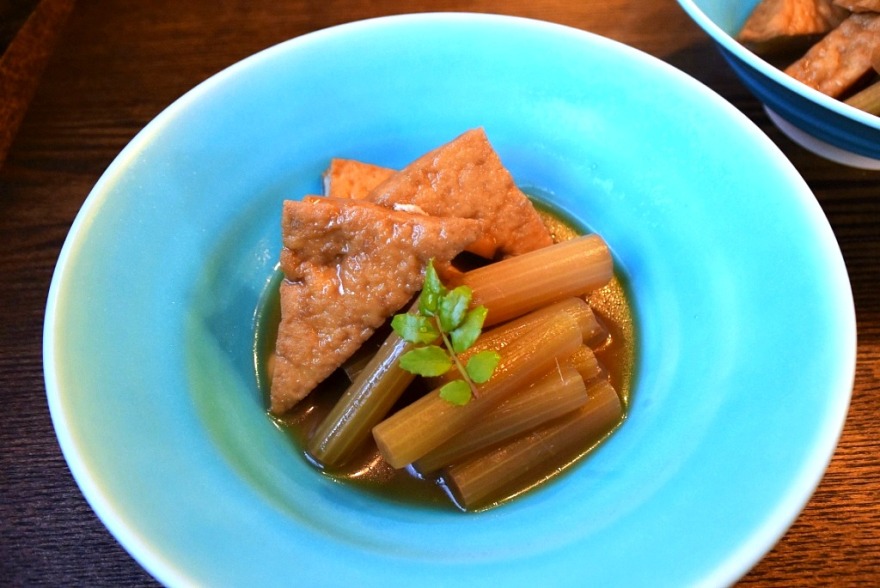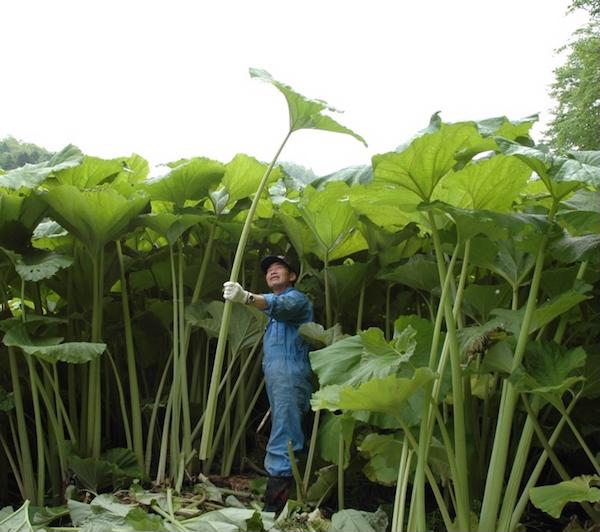Petasites japonicus is a splendid plant with many names and many uses. The word Petasites comes from ‘like a hat’, with reference to its large leaves. It has about fifty different common names, each more exotic than the last. Here are a few of my favourites- Blatterdock, Bog Rhubarb, Bogshorn, Butterbur, Flapperdock, Japanese sweet coltsfoot, and Fuki. For simplicity’s sake, from now on I will refer to it as Fuki.
Fuki is a striking plant native to Europe and parts of Asia. It can serve as an ornamental, medicinal, or edible plant. This giant perennial has ‘umbrella leaves’ that can measure up to 48’ across, stout pencil rhizomes, and stalks that can grow up to a yard in height. It somewhat resembles a giant rhubarb plant, although they are not at all related. (Fun fact: rhubarb is in Polygonaceae, the Knotweed family, while butterbur is in Asteraceae, the Sunflower family.)

Each plant usually has between 3-6 deciduous leaves, and produces a large rhizome network underground. You can find Fuki in moist soil, likely in woodland areas around rivers and marshes. It prefers shade, either partial or full. It is a very easy plant to establish in your garden, as its only essential habitat requirement is moist soil. In fact, since the introduction of this plant into Canada, it is actually seen as an invasive, since it spreads easily and is very difficult to remove once established. Even in regular flower beds, it can overtake other plants fairly quickly by blocking the sunlight with its large leaves. Therefore before planting it in your garden, make sure you have thought about controlling its spread. This could be through planting root barriers at the desired perimeter, or planting it into large containers and then sinking them into the ground.

As previously mentioned, Fuki is valuable for more than just its simple aesthetic appeal. It is both nutritious and medicinal! Fuki’s health benefits include provision of beta-carotene, Vitamins B1, B2, B3, and C, and minerals like potassium and calcium. Fuki’s aroma components have been shown to resolve ailments including coughs, excess mucus, and pollen allergies. In the Middle Ages, it was used for treating plague and fever. Later on in the 17th century, Fuki was applied for coughs, asthma, and skin wounds. In modern times, commercial medicinal fuki products have extracts from the roots, rhizomes and leaves. Medicinal uses of fuki include treatment for symptoms like pain, upset stomachs, stomach ulcers, and migraines. Some people also apply butterbur extracts to the skin, which supposedly improves wound healing. The young leaves and petioles can also be consumed for medicinal purposes.
It is important to note that Fuki contains pyrrolizidine alkaloids, which can damage the liver and cause serious harm if not adequately removed in the treatment process. Therefore, raw, unprocessed products should not be used, as they may be toxic or cause further health issues. The correct preparation and safety of using this plant remains somewhat controversial, although multiple studies have confirmed the health benefits of Fuki for migraines and pain relief.
The stalks are also edible if cooked properly. They reputably have a succulent and slightly bitter taste, somewhat similar to celery or cucumber. Preparation consists of boiling the stalks, then soaking them in water after rolling them in salt against a cutting board, to loosen skin and reduce the bitterness (this procedure is called itazuri preparation).

With respect to permaculture, this plant has multiple functions. In addition to those previously mentioned, it can provide great shade (potentially creating some microclimates!), a living fence, and stabilize areas with potential erosion risk. It also quickly provides biomass, which can be used for countless other functions.
In summary, if you have this plant taking over your backyard (or are interested in introducing this exotic into your garden life in moderation) and are unsure of what can actually be done with it, here are some suggestions:
- Make a medicinal extract to treat various ailments
- Use these large leaves as umbrellas
- Impress your gardening friends stuck with small-leaved plants
- Make a fast growing fence or quickly fill out your garden beds
- Prepare the shoots, and make a tasty Japanese-inspired dish (see here for suggestions)
By Wendy Fleming
References
Butterbur. (2017) NCCIH. https://nccih.nih.gov/health/butterbur
Butterbur. (n.d.) WebMD. Accessed from https://www.webmd.com/vitamins/ai/ingredientmono-649/butterbur
Fuki & fuki no to/ Japanese butterbur & butterbur buds. (2012). Recipes for Tom. Accessed at http://recipesfortom.blogspot.ca/2012/03/fuki-fuki-no-to-japanese-butterbur.html
Japanese Butterbur. (2018). Gardening Know How. Accessed at https://www.gardeningknowhow.com/ornamental/groundcover/japanese-butterbur/japanese-butterbur-plants.htm
Japanese Butterbur. (2016). The Laidback Gardener. Accessed at https://laidbackgardener.blog/tag/japanese-butterbur/
Petasites. (2018). ScienceDirect. Accessed from https://www.sciencedirect.com/topics/medicine-and-dentistry/petasites
Images:
1.https://qlip-trip.com/articles/21
2. Taken by student
3. http://recipesfortom.blogspot.ca/2016/05/fuki-to-atsuage-no-nimono-genen.html

